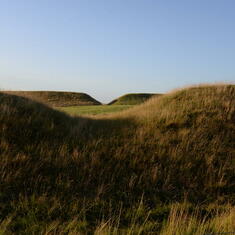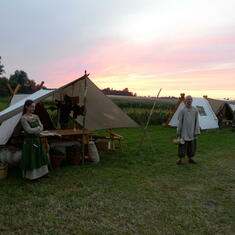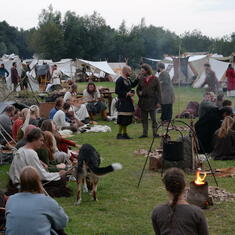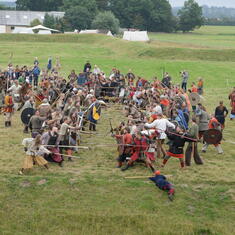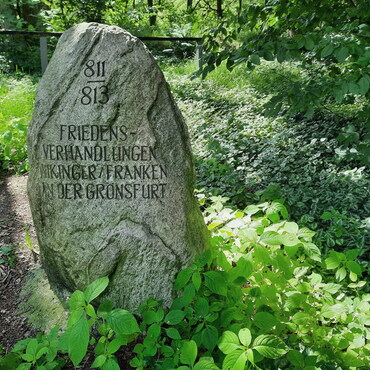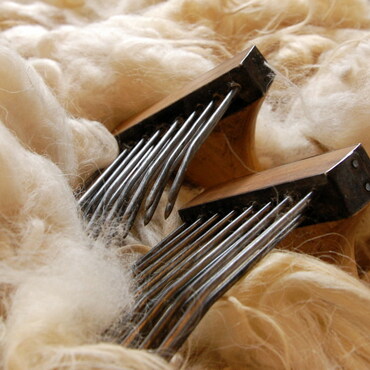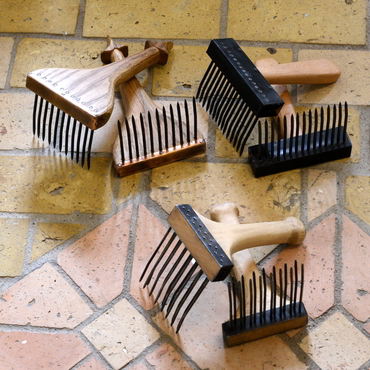And since the world is very small, we met some friends from Berlin who we got to know at the Midgardsblot 2016 in Borre, Norway. We had a nice time, visited the evening rabbits at the Schlei and the next day the Summer market at Hedeby. For people from outside this hobby, this visit would probably have been over after one and a half hours or so. Well, we got stuck talking about oval brooches first with a Swede and then with a Dane, which alone took us about three hours. Then we had to say hi to some people we would have met on the Danish markets anyway (which we didn't know back then) - it's always the same.
We continued our journey in the early afternoon and arrived at the Trelleborg in Slagelse a few hours later. There we quickly learned that the Danes do market organization - and almost everything else - in a relaxed way that seems somewhat strange to the German at first. There is a nice pointy, five letter word describing this state of being: hygge.
Quantity and quality
We were used to the German markets, so Trelleborg really was something else. There were more than 1200 Vikings - now put this into tents and shops! If you wanted to go over the whole market, look at the things and talk to the people, it was impossible to do it in one day. And it wasn't quantity alone that impressed us. Every morning before the market opened, the vølva's voice flew over the place, calling for the morning meeting. There, one would get the most important information of the day, be it the weather forecast (which you tend to distrust after a while since it's Denmark), the last day's visitor numbers, important events of the day (programme during opening hours, the next night's party, time of Viking flea market, etc.), lost and found or anything else that needed to be talked about. Everyone could say whatever troubled him or her, no matter the age, status or whatever. Every day, people were reminded to stay authentic after opening hours, which, we've heard, was not that normal at Scandinavian markets for a long time but did not seem to be an issue this year.
Most products were of such authentic and high quality that it became really difficult to leave the hack silver in the purse. But good craftsmanship needs to be rewarded and so we bought some new tools, new jewelery and other useful stuff. Of course, we also sold something. And rightfully so, because who would not want a nice weaving shuttle made of yew, smooth nalbinding needles, nicely balanced spindles and handspun wool?
And for those that were just not convinced enough, there was the flea market. It was Vikings only, after the official market closed. You could bring anything, things you usually sell or things you just wanted to get rid of. Bargain, trade, exchange for money or other goods - be quick before someone else offers a better price! It was crowded, it was intense, it was loud, it was like a real market could have been like. I want that reindeer hide, so I give you this leather west, it might fit you better than me. Deal! Those wooden bowls look good, want some bone pearls?
Apart from that, Ása made a very nice trade with another woman who had some spælsau wool with her and was curious about the East Friesian sheep's wool. Some spælsau for as much East Friesian sheep as she wanted - that woman was really happy afterwards (she had more spælsau at home) and Ása can now look forward to separating wool and hair of this "Viking" sheep breed.
Authentic Camp of the Year
In order to raise the motivation for steady improvement, the organizers introduced the choosing of the "Most Authentic Camp of the Year" some time ago. By making it a small competition, a game, people are probably more likely to improve themselves over the time. If you win, you get a small price: a "Trelleborg bowl", a replica of a bowl that was found at the Trelleborg. But in our opinion, the greater price is that your camp was chosen to be the most authentic one!
It works like this: the whole market place is divided into four areas 1-4. For every area, some people are chosen to be the "authenticity police" (let's call them "A-police"). The A-police from area 1 then checks all camps from area 2, A-police 2 checks area 1 and areas 3 and 4 cross-check each other as well. From each area three nominees are chosen (makes twelve nominees in total). Those are then checked by the "Super-A-police" consisting of market organizers, museum staff and members from the society "Trelleborgs venner". Since all nominees already are top-notch, it's now all about details.
We think this is a good way to improve the overall authenticity of a market. People are motivated by a small competition. And since nothing is really at stake, it all happens in a very friendly manner. You can point out things in other people's camps that could be improved (as they might do with your camp), but you might also feel obliged to look at yourself and your own camp more critically. And if everyone just strives to surpass his or her neighbour, the market might propel itself into an unbelievable quality.
Battle of beliefs
The Trelleborg - which is one impressive, substantial thing! - was built by Harald "Bluetooth" Gormsson, among other fortresses, to strengthen his position in the just Christianized Denmark. Conversion to a new belief system is never easy, especially when it is forced upon you. So one of Harald's sons, Sveyn Forkbeard, rebelled against his father (he probably had more reasons, but he was a pagan). Sveyn eventually defeated Harald and took the throne.
At the Trelleborg Viking Festival, a battle between Harald's and Sveyn's army was re-enacted in front of the fortress. Gudrun, the Vølva from Ribe, supported Sveyn's pagan army, whereas an Icelander (who's probably not known for his holiness) played a praying, fighting and baptizing priest on Harald's side. The battle was fought on Friday, Saturday and Sunday and lasted for three rounds - although Þór made Sunday's battle somewhat shorter by drenching everyone from above. Hundreds of warriors met on the battlefield as allies or foes - but in the evening, of course, it was all friends and the parties crossed all boundaries between age (excluding children...) and ethnicity. It felt like there was always some major party.
But then, Moesgård came...
